Matt Wilkinson reports on InXitu's award winning portable x-ray diffraction/x-ray fluorescence system
Matt Wilkinson reports on InXitu’s award winning portable x-ray diffraction/x-ray fluorescence system
A key problem with analysing samples is having to transport them to a laboratory for testing, something that is impossible if the sample is a priceless wall painting in a tomb or a rock that is 36 million miles from Earth. The need to carry out analysis in situ has led many research groups to go to great lengths to develop miniature, portable analytical instruments.

US-based InXitu’s range of portable x-ray diffraction/x-ray fluorescence (XRD/XRF) analysers is the product of one of these gallant efforts - with applications ranging from searching for life on Mars and natural gas on Earth, to identifying fake drugs and saving the tomb of Egyptian pharaoh Tutankhamen.
InXitu in situ
The InXitu story started 15 years ago when Nasa astrobiologist David Blake decided to see if an XRD/XRF instrument could be used to analyse rocks on Mars for signs of life. Aided by his then-postdoc Philippe Sarrazin, he developed a system that had no moving parts, replacing the goiniometer used in XRD systems to rotate a sample in the x-ray beam with a sample vibration system.
The addition of a solid state x-ray detector led to the birth of the CheMin (Chemistry and Mineralogy) XRD/XRF instrument that will be one of the pivotal instruments used by the Mars Science Laboratory (MSL), which is scheduled to launch on 15 September 2011.
The MSL, otherwise known as Curiosity, has been designed to determine if life has ever existed on Mars, to characterise the Martian climate and geology, and prepare the way for human exploration. It will be the same size as a Mini Cooper car (about 2.7m in length) although it will be considerably more expensive - the total cost of the MSL project is estimated to be in the region of $2.3 billion (?1.45 billion). It will weigh around 900kg, including 80kg of analytical instruments.
A wide range of instruments are being developed for the MSL including a laser-induced breakdown system (LIBS) that will vaporise rock samples up to 7m away from the rover and analyse the emitted light to pinpoint areas of potential interest.
Then when the rover has found an interesting spot to analyse, the a -particle x-ray spectrometer will irradiate samples with a -particles and analyse the x-rays that are emitted to determine the elemental composition of the samples. The CheMin instrument will then be used to determine which minerals are present in the sample and their mineral structure.
Terra firma
Supported by a Small Business Innovation Research (SBIR) grant from the US government, Sarrazin set up InXitu to commercialise the technology developed at Nasa for the CheMin XRD/XRF instrument for more down to Earth purposes.
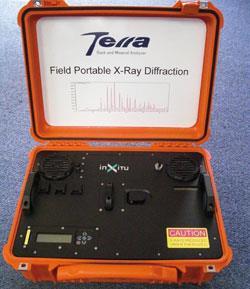
The California-based company’s first stop was to develop a field portable instrument (called the Terra)that can analyse the mineralogy of rocks in the field so that samples don’t need to be collected and then returned to the laboratory - which can be costly and time consuming, especially if the samples are taken from remote locations.
The current version of the Terra portable XRD/XRF instrument has been through a 10 year developmental cycle that saw four generations of instruments developed. Either side of that cycle the technology won industry awards. In 1999 the CheMin won an R&D 100 award, set up by the editors of R&D magazine to identify the 100 most significant R&D advances of the year. Then in 2009, the Terra won the Pittcon Editor’s Gold award. This annual prize is given to the best new product on show during the Pittsburgh Conference on Analytical Chemistry and Applied Spectroscopy (Pittcon), a major trade show for analytical instrument makers (see Chemistry World, April 2009, p44).
The technology has also been developed into a small, bench top instrument called the BTX for laboratory use. According to Brad Boyer, InXitu’s chief executive, the core technology in the Terra and BTX is identical to that used by CheMin, although the CheMin has been made of very expensive space-qualified components and has an autosampler as there will be no-one there to load the samples.
’One of the things that the Terra has changed is that rather than taking a rock sample to the laboratory, field geologists can now take the laboratory to the sample,’ says Boyer, who likens the introduction of the Terra to the introduction of the digital mobile phone. ’When the cell phone was introduced it really changed everything, people could take them with them, and it changed the way people approached using telephones and communicating with each other.’
By taking the Terra out into the field, Boyer continues, geoscientists can identify the minerals present in a rock sample in just minutes and confidently map out a vein of rock without having to send samples back to a laboratory for analysis.
One of the first commercial applications that the Terra was used for was in mud-logging, where rocks coming up from a bore hole are analysed so that the drillers can ensure that the drill bit is going where it should be. While the technique is sometimes used when drilling water wells and mineral exploration, it is most commonly used in petroleum exploration, which would historically use a surface gas detector to record the levels of natural gas being released as the hole is drilled.
Searching for gas
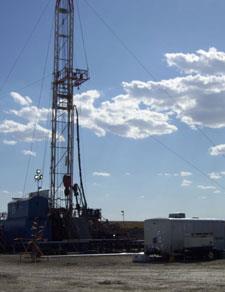
US-based oil and gas field service company Weatherford Laboratories has recently started using the Terra to help its customers gain faster and more accurate results when drilling for natural gas in unconventional rock formations, such as shale deposits.
According to Ryan King, field manager of the North American operations of Weatherford Laboratories unconventional reservoir services, interest in unconventional gas sources that are not simple to exploit has spiked over the past 10 years - particularly in the US. In collaboration with the Saudi Arabian oil giant Saudi Aramco, Weatherford Laboratories has developed its own portable pyrolysis instrument - the Source Rock Analyzer (SRA) - to determine the organic carbon content as well as available and potential hydrocarbon content of rocks at the well site.
’When our clients go to a shale formation they’ve explored and decided to produce from, they will use the data generated from the SRA to pick their most attractive target zones,’ says King. ’From there they will drill a lateral section parallel to the surface of the earth.’
’We collect cuttings samples that are brought up to surface by the mud system and analyse them using the SRA and the Terra to identify the rocks and their organic carbon content or commercial potential,’ he says. ’We’ll typically collect a sample every 10 to 100 feet, the client then uses the mineralogy data to work out where the best places are to fracture the rock to provide more pathways to release the gas.’
While these samples could be analysed in the laboratory, King explains, the wait for results could be anywhere from a week to a couple of months. In comparison, he says that by taking the instrument to the site, the samples are analysed in near-real time. Any extra costs incurred by opting for on-site analysis are ’massively offset by the client not having to move equipment to and from the location between drilling operations and completion operations’, he says.
King believes that the introduction of portable instruments is breeding a new generation of field personnel that have to understand both the science and the engineering, a combination which ultimately helps clients to get reliable results faster.
But the Terra itself is not limited to studying rocks, and has started playing a part in the fight against counterfeit pharmaceuticals entering the supply chain. According to Boyer, at least one major pharmaceutical company has been using this instrument to test for fake pharmaceuticals. The unique x-ray diffraction and fluorescent patterns that exist for each ingredient in a tablet makes counterfeit tablets easy to identify.
According to the World Health Organization (WHO) the problem of counterfeit medicines is worst in Africa, Asia, Latin America and former Soviet Union countries where fake drugs are estimated to exceed 20 per cent of the market share. By having an instrument that can quickly determine the authenticity of a drug at the source, authorities may be able to stop forgeries entering the market and save lives in the process.
Inside the box
The x-ray diffraction/x-ray fluorescence (XRD/XRF) combination used by InXitu makes clever use of two different responses that materials can have when irradiated by x-rays.
XRF allows quantitative elemental analysis from boron onwards, although most XRF is performed in the range of sodium to uranium due to sample preparation related issues. When irradiated with x-rays, an inner shell electron is displaced leaving a vacancy in that electron shell. An outer shell electron will then fall into the vacancy emitting energy (x-rays) specific to the difference between the two states. The energy produced is characteristic of the element, with the intensity proportional to the concentration of the element.
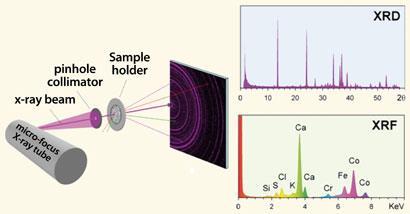
Meanwhile, XRD enables identification and characterisation of the structures of crystalline solids, with each crystal producing a distinctive diffraction pattern when bombarded by a known x-ray photon. The diffraction pattern works much like a fingerprint allowing the sample to be identified when compared to a database of chemical fingerprints. Mixtures can also be identified as the sample will show multiple structures superimposed upon each other.
By combining the elemental data obtained from XRF with the structural data from XRD, materials can be identified with high levels of confidence and accuracy.
Preserving the past
As well as helping in the fight against fraudulent medicine, the XRD/XRF technology is also being put to use to help save works of art. In collaboration with the Getty Conservation Institute (part of the Getty Center in Los Angeles, US), InXitu has adapted the technology for art analysis. The Terra was redesigned to reflect x-rays off a surface so that the surface of a painting or sculpture can be analysed without a sample being taken.
There are already many portable XRF spectrometers available that work in reflectance mode, and according to Giacomo Chiari, chief scientist at the Getty Conservation Institute, these handheld instruments are revolutionising the field of art conservation as they can determine the elemental composition of a sample without damaging it.
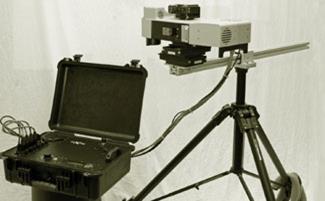
’A few years ago I saw an article about an XRD/XRF instrument that was being sent to Mars, and that instrument was built in transmission mode and needed samples to be taken, crushed and inserted between the x-ray tube and detector,’ says Chiari. ’I thought it would be fantastic if we could use a similar instrument in reflectance mode to determine the crystals and so I called InXitu’s Philippe Sarrazin [the author of the paper] to discuss the possibility of developing an adapted instrument.’
That conversation led to the development of the Duetto, an instrument that can not only determine the elemental composition of a piece of art, but also the chemical composition of the crystals.
’The advantages of the XRD/XRF approach is that you can obtain information about how the elements combine to give compounds and crystals, and this is a big advantage as you can find out if there is gypsum or calcite present. In contrast, a fluorescence instrument will only tell you that calcium is present,’ says Chiari.
’However, the instrument can only collect diffraction spots with [diffraction angles] between 20? and 55? due to geometric limitation, which means that you cannot classify clay minerals,’ says Chiari. ’But the biggest limitation that cannot be overcome by any modification of the instrument is that we rely on the object being suitable for analysis as it is - we cannot touch or sample it. The assumption is that the sample is crystalline or microcrystalline with a random distribution of crystals - and of course, not all samples are like this.’
The Duetto was first used to analyse the collection of antiquities, outdoor sculptures and manuscripts at the Getty Museum in the Getty Center. And will now be taken to the Roman ruins of Herculaneum (near Pompeii) in Italy to examine excavated murals for pigments, salts and deterioration products.
As part of a five year partnership between the Getty Center and Egypt’s Supreme Council of Antiquities, the Duetto is also being used to accurately record the present condition of Tutankhamen’s tomb in the Valley of the Kings and establish the causes of deterioration of the wall paintings so that a conservation programme for the tomb can be implemented.
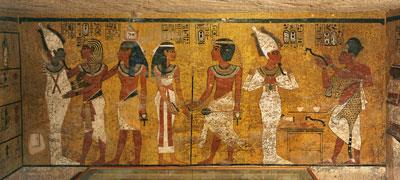
’Every time you deal with a very important object of art the first thing you want to do is to try to understand how it was made, what the components are, what any alterations are and what can happen if you change the conditions that it is stored in,’ says Chiari.
’This is a big part of the Tutankhamen tomb project where we want to see what effect the visitors are having on the paint in the tomb. The visitors bring humidity, CO2 and dust into the tomb and how these factors interact with the paints influence how you stop the tomb from degrading,’ he continued.
Chiari stressed that the Duetto is just one tool that art conservators have at their disposal, and no single technique will be able to solve every puzzle. ’The tools need to be used by expert people that know both the science and the context,’ he adds. ’The fact that analytical instruments have become easier to use does not diminish the need for skilled and experienced operators.’




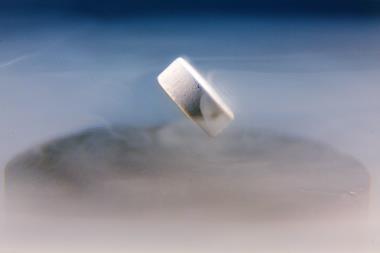
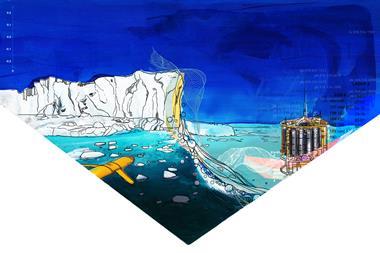
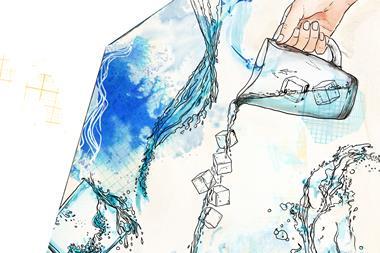
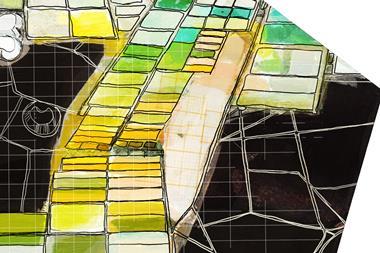
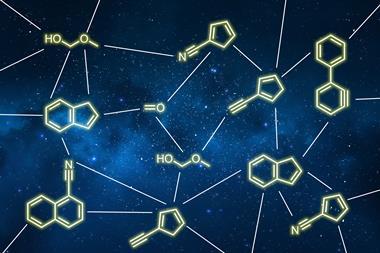
No comments yet